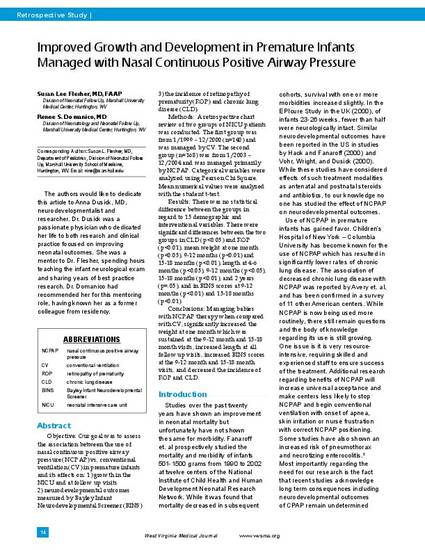
Objective: Our goal was to assess the association between the use of nasal continuous positive airway pressure (NCPAP) vs. conventional ventilation (CV) in premature infants and its effects on: 1) growth in the NICU and at follow up visits 2) neurodevelopmental outcomes measured by Bayley Infant Neurodevelopmental Screener (BINS) 3) the incidence of retinopathy of prematurity (ROP) and chronic lung disease (CLD).
Methods: A retrospective chart review of two groups of NICU patients was conducted. The first group was from 1/1999 – 12/2000 (n=140) and was managed by CV. The second group (n=168) was from 1/2003 – 12/2004 and was managed primarily by NCPAP. Categorical variables were analyzed using Pearson Chi Square. Mean numerical values were analyzed with the student t-test.
Results: There was no statistical difference between the groups in regard to 15 demographic and interventional variables. There were significant differences between the two groups in CLD (p<0.05) and ROP (p<0.01), mean weight at one month (p<0.05), 9-12 months (p<0.01) and 15-18 months (p<0.01), length at 4-6 months (p<0.05), 9-12 months (p<0.05), 15-18 months (p<0.01), and 2 years (p=.05), and in BINS scores at 9-12 months (p<0.01) and 15-18 months (p<0.01).
Conclusions: Managing babies with NCPAP therapy when compared with CV, significantly increased the weight at one month which was sustained at the 9-12 month and 15-18 month visits, increased length at all follow up visits, increased BINS scores at the 9-12 month and 15-18 month visits, and decreased the incidence of ROP and CLD.

Copyright © 2014 West Virginia State Medical Association. Reprinted with permission. All rights reserved.